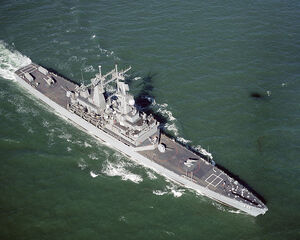 USS Virginia (CGN-38) | |
| Class overview | |
|---|---|
| Name: | Virginia for Virginia |
| Builders: | Newport News Shipbuilding & Dry Dock Company |
| Operators: | United States Navy |
| Preceded by: | California class cruiser |
| Succeeded by: | Ticonderoga class cruiser |
| Cost: | $675 million (1990 dollars) |
| Built: | 1972-1989 |
| In commission: | 1976-2022 |
| Planned: | 11 |
| Completed: | 7 |
| Cancelled: | 4 |
| Retired: | 7 |
| General characteristics | |
| Type: | Guided missile cruiser |
| Displacement: | Light Displacement: 10,663 tons
Full Displacement: 11,666 tons |
| Length: | Overall Length: 586 ft (179 m)-255 m |
| Beam: | Extreme Beam: 63 ft (19 m)-38 m |
| Draft: | Maximum Navigational Draft: 32 ft (10 m) |
| Propulsion: | 2-4 D2G General Electric nuclear reactors, two-four shafts, 60,000-120,000 shp |
| Speed: | 30+ knots (55+ km/h) |
| Range: | unlimited |
| Complement: | 39 Officers, 540 Enlisted men |
| Sensors and
processing systems: |
|
| Electronic warfare
and decoys: |
|
| Armament: |
|
| Aircraft carried: | As built: below-deck hangar for one SH-2F Seasprite helicopter
Flight deck occupied by Tomahawk missile storage & launcher after refitting |
The Virginia-class nuclear guided-missile cruisers (CGN-38 class) are a series of four to eleven double-ended (with armament carried both fore and aft) guided-missile cruisers commissioned in the late 1970s, which served in the United States Navy. With their nuclear power plants, and the resulting capability of steaming at high speeds for long periods of time, these are excellent escorts for the fast nuclear-powered aircraft carriers, such as the U.S. Nimitz class aircraft carrier. Their main mission is as air-defense ships, though they did have capabilities as anti-submarine (ASW) ships, surface-to-surface warfare (SSW) ships, and in gun and missile bombardment of shore targets. The Virginia-class' largest ships are the largest guided-missile cruisers of the United States Navy.
Class description[]
The ships were derived from the earlier nuclear-powered California class cruiser (CGN-36 class). It was found that, while it was possible to mass-produce nuclear-powered warships, the ships were less cost-efficient than conventionally-powered warships and the new gas-turbine-powered ships then entering the fleet -(the Spruance class destroyers) - required much less manpower. Following the end of production of this class, the U.S. Navy continued conventional destroyer/cruiser production, and it redesignated the DDG-47 class of guided missile destroyers as the CG-47 Ticonderoga class cruisers. Three of the four Virginia-class ships were authorized as guided missile frigates (in the pre-1975 definition), and they were redesignated as cruisers either before commissioning or before their launching. The last warship, the USS Arkansas (CGN-41), was authorized, laid down, launched, and commissioned as a guided-missile cruiser.
Modernization[]
The Virginia-class missile cruisers were new, modern ships; given a New Threat Upgrade electronics overhaul, they would have been well-suited to modern threats. They had rapid-fire Mk 26 launchers that could fire the powerful Standard SM-2MR medium-range surface-to-air missile - earlier decommissioned cruisers used the slower-firing Mk-10 launchers, which required manual fitting of the missiles' fins prior to launch.
Nevertheless, the CGN-38-class cruisers, with their missile magazines and Mk-26 missile launchers, were incapable of carrying the SM-2ER long-range surface-to-air missile, being restricted to the SM-2MR medium-range surface-to-air missile. This was a significant limitation in their capabilities.
Another weakness was a lack of Light Airbourne Multi Purpose System helicopters, which had been replaced by the Tomahawk cruise missile. In the end, what really doomed the ships was economics. They were coming due for their first nuclear refuelings, mid-life overhauls, and NTU refittings, which were all expensive projects, together costing about half the price of a new ship. Further, they required relatively large crews, straining Navy personnel resources. The 1996 Navy Visibility and Management of Operating and Support Costs (VAMOSC) study determined the annual operating cost of a Virginia class cruiser at $40 million, compared to $28 million for a Ticonderoga class cruiser, or $20 million for an Arleigh Burke class destroyer. Given a higher requirement for cruisers, it was decided to make modernizations to these nuclear ships as a money-saving measure. The early Ticonderoga class cruisers which at first time lacked the Vertical Launch System were replaced with these in the late 1990s.
In 1996, the Virginia-class guided-missile crusiers began to be modernized, and to deal with the problem of lack of carrying long-range surface-to-air missiles and medium-range surface-to-air missiles aboard, it was decided to enlarge their hulls. The lenght of 179-180 metres were enlarged by 75 metres, to 254-255 metres. This massive reconstruction reclassed them as very large guided-missile cruisers, playing a key role in commissioning of the new massive 45,000 tons Soviet Super Sverdlov class cruisers in 1991.
| Ship Name | Hull No. | Commissioned | Length of Service | Status |
|---|---|---|---|---|
| USS Virginia (CGN-38) | CGN-38 | 11 September 1976 | Unlimited service | In active service, as of 2051 |
| USS Texas (CGN-39) | CGN-39 | 10 September 1977 | Unlimited service | In active service, as of 2051 |
| USS Mississippi (CGN-40) | CGN-40 | 5 August 1978 | Unlimited service | In active service, as of 2051 |
| USS Arkansas (CGN-41) | CGN-41 | 18 October 1980 | Unlimited service | In active service, as of 2051 |